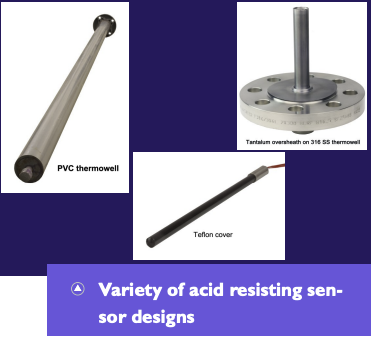Your Temperature Measurement Experts
Mini Case Studies from the Field
Corrosion Protection Options for Temperature Sensors
 Application
Application
A waste processing company was looking for an economical method to monitor the temperature of a variety of low concentration acids at around 80°F inside a large processing tank. A long sensor was required to reach the desired measurement point which meant that the exotic alloys normally used for acid applications would be very expensive. The available entrance into the tank was through a standard ANSI style flange.
Challenge
There are a limited number of materials that are suitable for use in acids and work well for housing a temperature probe. The long length meant that a direct immersion probe or thermowell would have to be robust enough to withstand the fluid flow in the tank while it was being filled and drained. Given an unlimited budget a Hastelloy or Tantalum sheathed thermowell to house the RTD would be an easy solution.
Solution
Variety of acid resisting sensor designs Corrosion Protection Options for Temperature Sensors PVC was chosen as a low cost, yet still very capable, material to resist the corrosive effects of the acids present in the tank. To achieve the necessary rigidity, 3” CPVC was chosen to fabricate the thermowell which included a short tip section of 1/2” pipe that housed the RTD sensor. Fabrication used all readily available fittings and adhesive. Other options for the measurement were a Tantalum over-sheath on a flanged well, Teflon® coating, Hastelloy, and other plastics. All of which were many times more expensive. Another solution for applications where an immersion style sensor cannot be used is a surface mount RTD or thermocouple. Check out the Series B sensors for more options.
If you are interested in learning more about Burns Engineering and our custom temperature sensor solutions, contact us today.
